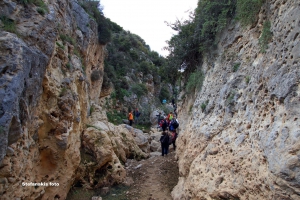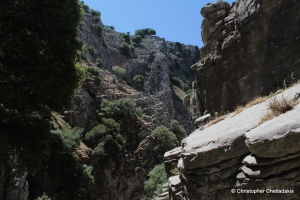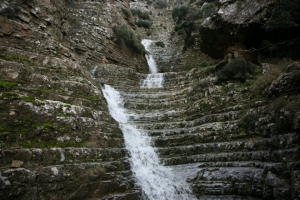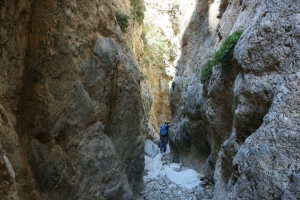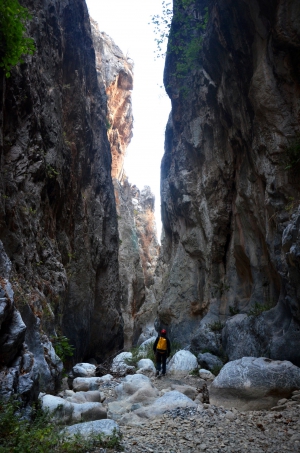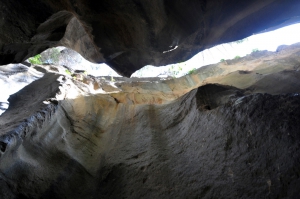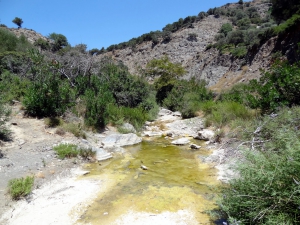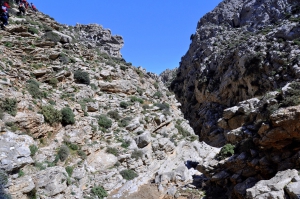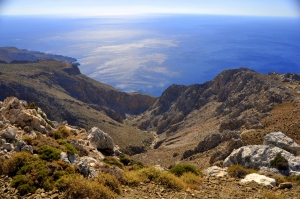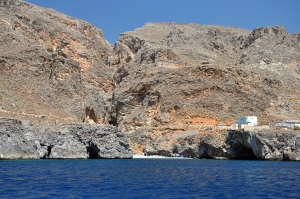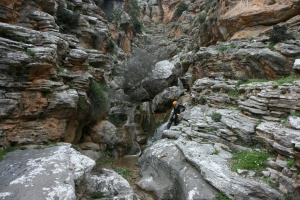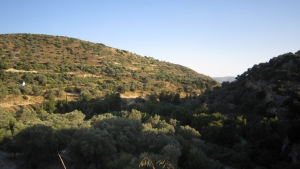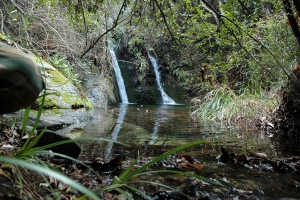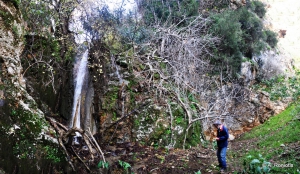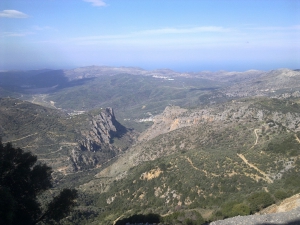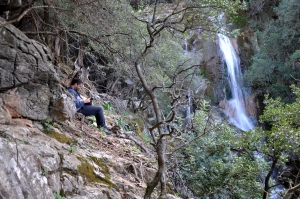The Gorge of Agia Anastasia starts from Kenourgio Horio, Province Pediada (altitude 160m) and ending at the seaside settlement of Gournes. The name is taken after the cavernous chapel of St. Anastasia, located near its entrance. The vegetation is restricted to oleanders and the walls get narrow in several points. The descent of the gorge takes about three hours.
One of the most impressive and longest canyons of the entire island of Crete is the canyon with the cacophonous name Psoraris (Greek: someone who suffers from scabies). Its exit is located at the mountains of Dikti, above the village Geraki and it starts from the plateau Parasyrta. There are three different mountain roads, all of unique beauty: from Lassithi plateau (village Kaminaki), from Geraki and Katofygi by Viannos.
The gorge of Eligas is a monument of natural beauty located on the west side of the mountain Koupa near the village Miliaradon by Embaros. It is actually a high waterfall with nine rapels, ideal for canyoning. The difference of altitude between the entrance and the exit is about 230m.
The gorge of Psaro Nero is located 55km southeast of Heraklion. It is a short inaccessible canyon with high waterfalls (rapels), very well known to canyoners of Crete. Psaro Nero with its wonderful rock formations has water till late spring. It is initially open and closes abruptly close to the end, where the high rappels are (the highest is 25m). The gorge empties into Baritis River, a tributary of Anapodaris, near Katofygi.
On the southeast side of Afendis Christos summit, above the villages Embaros you will meet the verdant vineyards at Erganos plateau at 900 meters altitude. The water gathered from the melting snow of the surrounding slopes and from many springs of the region form the main tributary of the Anapodaris river, Baritis, which crosses the plateau of Erganos and forms the rugged canyon of Erganos.
The canyon of Panagia (Virgin Mary), also known as Kalami I is parallel to the gorge Xerofarago or Kalami II and takes its name after the former monastery of Panagia Keralimeniotissa located at its exit.
Xerofarago Gorge is located south of Kalami village (Viannos area), 75km southeast of Heraklion. It is a small gorge ideal for canyoning (known to the canyoners as Kalami II) that terminates close to the old church of Panagia Keralimeniotissa, where another gorge, Kalami Gorge ends.
The canyon of Tsoutsouras is located in Tsoutsouras village and is one of the many inaccessible canyons of the area. It starts at position Sfakias and it's exit is located near the settlement, in Larinaki area, and at first glance it causes awe.
The gorge of Mindris starts near the village Filippi and ends at the port of Tsoutsouras, after running a distance of 6km. It is a open canyon without vertical walls, which’s riverbed is dry in summer and very easy to walk. On the riverside traces of ancient settlements, ranging from the Minoan to Roman Era have been found.
The Gorge of Ethia, officially known as Vorno, is located south of Heraklion, at the Asterousia Range. It starts from the village Ethia and, after tearing Asterousia northwards, it finishes at the plain of Messara, between the villages and Rotasi and Mesochori.
A very wild gorge starting from the valley of Pervola, next to Mournia village at Asterousia Mounts, and ending on the remote amazing beach of Kaminaki. There is a trail, quite steep, starting from Pervola.
The wild and inaccessible canyon of Mesosfini is located 55km south of Heraklion city, in an isolated area west of the seaside village of Treis Ekklisies. Its entrance is located at a height of 450m, near the village of Mournies and Prinias, in the Asterousia Mountains. At its exit, 2km south, it is formed the majestic beach of Voidomatis, which can be accessed via a dirt track from Tris Ekklisies.
Just a few meters to the west of Tsoutsouros, the very narrow and smaller gorge of Troulla is formed. Being shorter than the Tsoutsouros canyon, it has attracted the attention of the canyoners and is very impressive with more than 15 beautiful waterfalls along its bed, the largest being 15m high.
Martsalo gorge has a length of about 2km and is located in the south coast of Asterousia Mountains, in Heraklion Prefecture. It starts from the north and ends at the Libyan Sea, in the small picturesque beach of Martsalo. Apostle Paul stopped in Martsalo, during his journey to Rome.
Apolychnos Gorge is located a few kilometers north of Mires town, in a lush green area with dense olive groves. It's actually a narrow valley running along a river, which in some places gets deeper and the vegetation is very dense.
A few minutes away from the city of Heraklion, close to Agios Panteleimonas Monastery by Fodele, there is the canyon of Santorinios. The canyon is short but has not been exploited yet due to its quite difficult access, because of the dense vegetation and many ponds.
West of the village Rogdia a small gorge is formed that exits at the area of Paliokastro. It initially starts at position Koukos, where we meet the ruins of an old watermill.
The Gorge Porofarago or Sfakoryako is a small canyon, almost 2 km long, starting from village Kato Vatheia and ending near the settlement of Vrachokipos. It is crossed by the river Krommidas carrying water on the beach Kokini Hani.
The Gorge of Ambelos is located southeast of Gonies village (Hersonissos Municipality), just about one km from the southern limits of the village. The approach is easy from the rural road, which runs through the gorge, along the bed of a tributary of Aposelemis river.
Gorge of Embasa starts its course from the village Kato Kera and ends near the village Gonies, being about 2km long. Its upper part is very steep and in winter several waterfalls are formed, with the highest being about 20m high.










